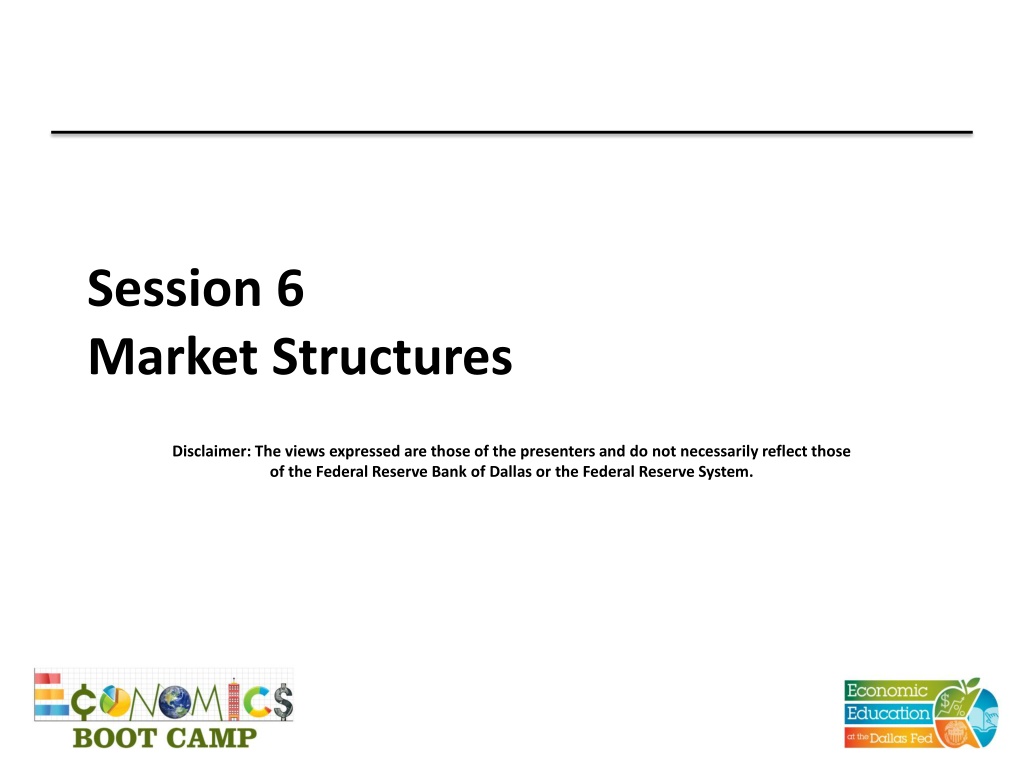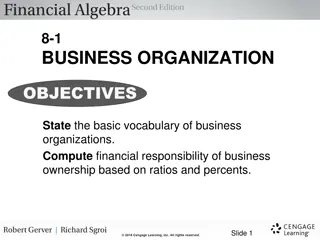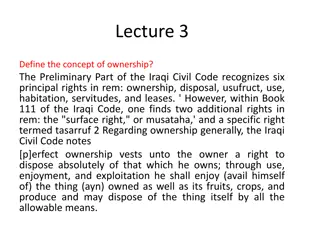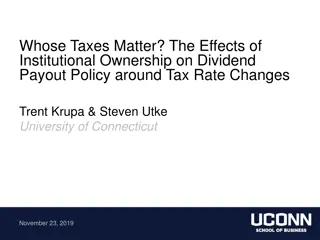Understanding Market Structures and Business Ownership
Explore the characteristics of different market structures like pure competition, monopolistic competition, oligopoly, and monopoly. Learn about types of business ownership such as sole proprietorships, partnerships, and corporations. Discover the regulations affecting businesses and the economic rights and responsibilities involved. Delve into terms like product differentiation, financial capital, and profit to gain a comprehensive understanding of market dynamics.
Download Presentation

Please find below an Image/Link to download the presentation.
The content on the website is provided AS IS for your information and personal use only. It may not be sold, licensed, or shared on other websites without obtaining consent from the author. Download presentation by click this link. If you encounter any issues during the download, it is possible that the publisher has removed the file from their server.
E N D
Presentation Transcript
Session 6 Market Structures Disclaimer: The views expressed are those of the presenters and do not necessarily reflect those of the Federal Reserve Bank of Dallas or the Federal Reserve System.
TEKS (9) Economics. The student understands types of market structures. The student is expected to: (A) describe characteristics and give examples of pure competition, monopolistic competition, oligopoly, and monopoly; and (B) identify and evaluate ordinances and regulations that apply to the establishment and operation of various types of businesses.
TEKS (16) Personal financial literacy. The student understands types of business ownership. The student is expected to: (A) explain the characteristics of sole proprietorships, partnerships, and corporations; (B) analyze the advantages and disadvantages of sole proprietorships, partnerships, and corporations; (C) analyze the economic rights and responsibilities of businesses, including those involved in starting a small business; and
Teaching the Terms Pure competition Monopolistic competition Oligopoly Monopoly Sole proprietorship Partnership Corporations Ordinance Product differentiation Intellectual property Liability Financial capital Profit
Two Classification Systems In what type of competitive environment does the business operate? How has the company chosen to organize itself?
Markets A market facilitates the interaction of a buyer and a seller as they complete a transaction Buyers, as a group, determine the demand Sellers, as a group, determine the supply
Competitive Markets Identical goods or services Enough buyers and sellers so that no participant can influence the market price everyone is a price taker
Imperfect Competition Goods or services that are not identical Restaurants, gas stations and hotels Markets dominated by single or small number of producers Computer operating systems, automobiles, diamonds,
Market Structures Are products differentiated? No Yes One Monopoly N/A How many producers are there? Few Oligopoly Monopolistic Competition Many Perfect Competition
Market Structures Influence on Price Product Differentiation Barriers to Entry # of Firms Advertising Perfect Competition Many None No No None Monopolistic Competition Many Limited Some Yes Limited Oligopoly Few Some Some Yes Significant Pure One Extensive No Yes Complete Monopoly
Natural Monopolies Some industries are characterized by conditions that create barriers to entry Location Economies of scale Utilities are the classic example Water Cable television Electricity
Protected Monopolies Barriers to entry in some industries are the result of specific protections granted by government Licenses Patents Examples Concessions in national park Pharmaceuticals
Types of Firms Sole Proprietorship Partnership Corporations
Sole Proprietorship Advantages Disadvantages Ease of start-up Full control Sole receiver of profit Easy to close Unlimited personal liability Limited access to resources (including financial capital) Limited life
Partnerships Articles of partnership or partnership agreement define rights and responsibilities Types of partnerships General partnerships Limited partnerships Limited liability partnerships
Partnerships Advantages Disadvantages Ease of start-up Shared decisionmaking Ability to specialize More access to financial capital Profit comes directly to partners Unlimited personal liability Potential for conflict Limited life
Corporations Articles of incorporation create an independent entity Owners are called shareholders Shares may or may not be publicly traded Shareholders elect board of directors Board of directors selects leadership of the firm
Corporations Advantages Disadvantages Ease of raising capital Limited liability for owners Transferable ownership Unlimited life Ability to hire experts Expense and difficulty of start-up Double taxation Owner-agent dilemma Increased regulation and requirements
Application http://www.econedlink.org/lessons/EconEdLi nk-print-lesson.php?lid=533&type=educator Facebook story























